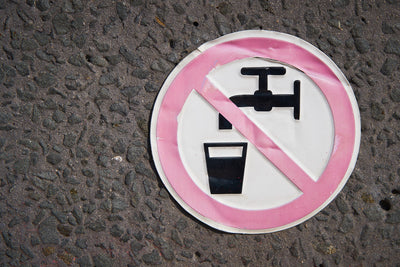Water Quality InformationWritten By Actual Experts
RSSBREAKING: EPA to Pull Regulation for Tap Water Contaminant

PFAS Contaminates Groundwater Near NY Incineration Facility
Anales Dyjak, M.A. | Policy Nerd
A new study out of Bennington College has shed light on new challenges as the federal government tries to figure out how to address PFAS contamination. PFAS, or "forever chemicals," are being found in tap water across the country. PFAS are known to cause a variety of health issues, including cancer and and an increased risk of miscarriages. PFAS compounds are a key ingredient in Aqueous Fire Fighting Foam or AFFF. All of these terms are used interchangeably in the media, including "forever chemicals" so we wanted to make to clarify.
Department of Defense and PFAS:
The Department of Defense has been responsible for deploying a significant amount of PFAS contamination into the environment. This is in part due to its presence in firefighting foam (AFFF), which is often used during on-base activities. Because there is no comparable alternative, the use of PFAS-containing AFFF is necessary for fire suppression. At the time PFAS and AFFF were first invented, sufficient predictive health modeling and epidemiology did not exist. Department of Defense must also consider a second issue, which is the impacts to on-base drinking water supplies. Military bases have their own water supply that’s separate from nearby municipalities. This means that DoD is responsible for determining the safety of the water being distributed to military personnel and their families. DoD has identified over 400 U.S. military bases whose water supply is contaminated with PFAS.
How Do We Get Rid of PFAS in the Environment?
There is no current "best practice" for PFAS mitigation and the government has yet to figure out how to properly dispose of PFAS chemicals. In a 2017 SBIR solicitation, the Department of Defense acknowledged that “no satisfactory disposal method has been identified” and “many likely byproducts will be environmentally unsatisfactory.” Despite both of these claims, the DoD entered contracts with incineration facilities in Ohio, Arkansas, New York, and more.
Public Health Crisis in Cohoes, New York
In 2018, the Norlite incineration facility in Cohoes, New York began burning AFFF from a contract with DoD. Residents of Cohoes were not made aware that the Norlite facility was burning AFFF until February 2020. Research out of Bennington College determined that because PFAS were being detected downwind of the Norlite plant, that the chemicals were not being fully incinerated. The researchers believe that this could be because the PFAS from DoD were used as a fire suppressant, making it unlikely that they would break down via incineration. The city of Cohoes is currently trying to pass a one-year moratorium on PFAS incineration so that further studies can be completed on impacts surrounding communities.
What Are PFAS?
PFAS have historically been used in firefighting foam, non-stick and stain resistant surfaces, and Teflon. PFAS use a carbon-fluorine bond, which is one of the strongest chemical bonds and extremely difficult to break down in the environment. There are a variety of health impacts associated with exposure to PFAS including; cancer, low infant birth weight, thyroid problems, and effects on the immune system. A recent study out of Yale University School of Public Health found that PFAS exposure increases the risk of miscarriages in pregnant women by 80-120%.Other Articles We Think You Might Enjoy:
Yale Study Finds That PFAS Linked With Increased Risk of Miscarriage
How Does Lead Enter Drinking Water?
Supreme Court v. Clean Water Act
Yale University: PFAS Linked With Increased Risk of Miscarriage

Analies Dyjak, M.A. | Policy Nerd
A recent study out of the Yale School of Public Health found that PFAS are linked to an increased risk of miscarriages in pregnant women. Our Water Nerds would like to acknowledge that the matter of this study regards a sensitive subject for families across the world. Though this information may be jarring, it further emphasizes the dangers of PFAS exposure and why finding a solution should be a top priority.
About The Yale Study:
Dr. Zeyan Liew, the lead researcher of this study, has focused a majority of his professional career to studying perinatal epidemiology. There are only three total studies that have assessed PFAS exposure and miscarriages, this study included. The Yale researchers used data from the Danish National Birth Cohort (DNBC). The study assessed 220 pregnancies ending in live births (control) and 220 pregnancies ending in miscarriages. The sample size of the research was limited by the cost of testing for PFAS in maternal plasma.
What Did The Study Find?
The Yale University PFAS study evaluated prenatal exposure to seven different PFAS variations, and the risk of miscarriage. The study tested the more common types of PFAS typically found in drinking water; PFOS, PFOA, PFHxS, PFHpS, PFNA, PFDA, and PFOSA. The study determined that the cohort of women with higher amounts of PFAS in their maternal plasma had an 80% to 120% increased risk of miscarriage than those with lower amounts of PFAS. The researchers listed drinking water, food packaging, indoor air, and "other" environmental exposures as the primary routes of ingestion/inhalation into the human body.
PFAS: What You Need To Know
Per and Polyfluoroalkyl Substances (PFAS) are being detected in a growing number of tap water supplies across the country. Because PFAS are considered to be an “emerging contaminant,” there are very few credible studies that show associations with exposure to PFAS and negative health effects. Up until this point, a majority of PFAS toxicology studies have been completed on laboratory mice. This particular Yale study is one of the few completed entirely on pregnant women. As with any epidemiological study, more research is necessary to further elucidate the causal connection between PFAS and an increased risk of miscarriage.
PFAS are unregulated, meaning that most municipalities are not required to test, monitor, or remove them from tap water. Further, private well owners are entirely on their own for determining if PFAS is in their well water. EWG has begun mapping out areas of the country that have detected PFAS in finished tap water. Although EWG is a great preliminary resource, it’s important to note that they do not have data on every city in the United States. If your municipality is not on the map, it does not mean that your water is free of PFAS. If you're curious to see if your water has been tested for PFAS, click here.
Disclosure: Make Sure Your Filter Removes PFAS
A study by Duke University and NC State University tested major water filtration brands and their ability to remove PFAS. Hydroviv Undersink and Refrigerator Line water filters removed PFAS better than most major brands. PFAS present in the unfiltered sample had undetectable (below the Method Detection Limit (<MDL) in the Hydroviv filtered water. To our surprise, the study found that many well known brands did not do a great job at removing PFAS. Filtration brands including Brita, Pur, Zerowater, Samsung, and GE failed to bring PFAS levels down to undetectable.
Some brands, including Berkey, Aquasana, and Puronics actually leaked PFAS from the filtration media back into drinking water… This is often the result of over-saturation and low-quality filtration media. The Duke study also evaluated various Reverse Osmosis (RO) filters. Data from each of the RO systems that were tested found undetectable levels of PFAS in the filtrate.
Other Articles We Think You Might Enjoy:How Did Hydroviv Filters Perform in a PFAS Filter Study?
The Other Contaminant From The Flint Water Crisis That No One Is Talking About...
How Do I Know If My Home Has Lead Plumbing?
BREAKING: The Supreme Court Sides With Clean Water

Analies Dyjak, M.A. | Policy Nerd
In a 6-3 landmark decision, the Supreme Court has sided in favor of clean water. County of Maui, Hawaii v. Hawaii Wildlife Fund tested a decades-old precedent relating to water pollution. The case calls into question whether or not indirect discharge of wastewater into a navigable water requires a permit from EPA.
Background: County of Maui, Hawaii v. Hawaii Wildlife Fund
In the late 1970’s and early 1980’s, the County of Maui built four injection wells to store treated wastewater. The use of injection wells was, at the time, the best option for dealing with treated sewage. The County was trying to prevent treated sewage from directly ending up in the Pacific Ocean. In 2013, the U.S. Environmental Protection Agency, alongside Hawaii state agencies, decided to study the environmental impact of the County's injection wells on Maui’s shoreline. A “tracer dye test” ultimately determined a hydrologic connection between the treated sewage from the injection wells and coastal Maui waters. Even though the County didn't directly discharge sewage into the Pacific Ocean, it was still ending up there via the injection wells. The county argued that because groundwater has historically been considered "non-point" (meaning no permit required) that it does not fall under the jurisdiction of the Clean Water Act. Because of this, the county believed that it was not liable under the Clean Water Act to obtain the proper permits required for point source pollution. The case made it's way through the Courts to the Ninth Circuit, who sided with the Hawaii Wildlife Fund. The County of Maui filed a petition for writ of certiorari and the case was heard by the Supreme Court.
How Did The Supreme Court Side?
On April 23, 2020, the Supreme Court sided in favor of Hawaii Wildlife Fund, and ultimately in favor of water. “We hold that the statute requires a permit when there is a direct discharge from a point source into navigable waters or when there is the functional equivalent of a direct discharge.” This quote from the opinion of Justice Stephen Breyer challenges the underpinnings of the Clean Water Act. It’s interpretation, however, is seemingly, and purposefully, broad. It’s obvious that the Supreme Court continues to grant primacy to EPA and Congress.
How Will This Change Precedent?
The decision of the Court challenges existing Clean Water Act (CWA) provisions. According to the CWA, a permit is not required for non-point source pollution into groundwater. The Court determined that discharge from an injection well is in fact considered “point source pollution,” which does require a permit. Does the term “functionally equivalent” apply to non-point source pollution other than wastewater? Does this apply to all other groundwater conduits? These are questions we hope to have answers to in the upcoming weeks.How Will This Impact Drinking Water?
The question of whether or not groundwater conduits should be regulated equivalently to point-source conveyances opens up a whole can of worms. As the Clean Water Act currently stands, groundwater, including private wells, is not regulated. This means that private well owners are entirely on their own for determining the safety of their drinking water. Justice Breyer could be calling for a broader range of regulated "groundwater" - resulting in less polluted aquifers for private wells. Alternatively, surface water quality across the country has the potential to drastically improve. In theory, more types of non-point source pollution could require permits/oversight, therefore resulting in cleaner water. Many lakes and rivers act as the primary drinking water source for major cities. For example: Chicago gets its water solely from Lake Michigan, Washington, D.C. draws water from the Potomac River, and Columbus, Ohio utilizes the Scioto River. All of these water sources are susceptible to pollution from various sources, including, but not limited to, wastewater injection wells.
If you have questions about this case and how it might impact your drinking water, feel free to send us an email at hello@hydroviv.com.
Other Articles We Think You Might Enjoy:How Did Hydroviv Perform in a Duke University PFAS Removal Study?
How Changes To The Waters Of The United States (WOTUS) Rule Affects Drinking Water
How Does Lead Enter Drinking Water?
Stagnant Water From COVID-19 Will Increase Lead in Schools

*Updated August 27, 2020 to include recent water quality reports.
Analies Dyjak, M.A. | Policy Nerd
COVID-19 will have long-lasting impacts that we can’t even begin to quantify. One important challenge that has the potential to be overlooked in the enormity of the crisis is that water quality, specifically in schools and childcare facilities, could change when stay-at-home orders are lifted. Purdue University is currently researching the magnitude of just how bad this problem could be. Here is how lead in water could impact schools in your area.
There is NO Safe Level of Lead For Children
Exposure to any amount of lead can cause serious health impacts, particularly in young children. According to the American Academy of Pediatrics (AAP), exposure to low levels of lead can cause permanent cognitive, academic, and behavioral difficulties in children. There is a serious disconnect between the legal limit and the levels deemed appropriate by major health organizations. Lead is a neurotoxin, and children should not consume any amount, especially at school.
Why Does Stagnant Water Increase Lead Levels?
Lead accumulates in water when it leaches from lead-containing pipes, plumbing, and fixtures. The periods of inertia in plumbing during weekends and summer vacation allow water to sit stagnant for extended periods of time. The longer water sits stagnant in pipes in the distribution system, the more lead can accumulate. This is the major difference between lead accumulation in homes vs. schools and childcare facilities. Some school districts make sure to flush pipes in August before the start of the school year. Unfortunately, some schools don’t have the funds to ensure proper flushing. In an average household, water flows on a daily basis and doesn’t sit stagnant for more than 12 hours at a time. We don’t know how long schools will be closed, which could result in water sitting stagnant for longer than the average summer break.
Why Are Schools and Childcare Facilities Most Susceptible To Lead Contamination?
Schools in the United States are old, and many were built with lead-containing pipes, plumbing, and fixtures. According to data from the Department of Education, the average age of a public school in the United States is 44 years old. Additionally, children are particularly vulnerable to the negative effects of lead exposure. The current federal Action Level for lead in drinking water is 15 parts per billion. Unfortunately, schools are not required to follow this already weak standard for municipal water. The EPA suggests schools maintain lead levels under 20 parts per billion. This is shocking, considering that public health organizations agree that there is no safe level of lead for children.
What is Legionnaires' Disease and Why Is It Being Detected In Schools' Drinking Water?
The New York Times recently reported that several school districts around the country have detected Legionella, the bacteria that causes Legionnaires' Disease, in schools' drinking water. Legionnaires Disease is a type of pneumonia that can form in stagnant water. It's spread through the inhalation of small water droplets that contain the disease - from sources including showers, toilets, and water fountains. Prolonged school closures due to COVID-19 are the ideal environment for Legionella to manifest in drinking water.
Why Many Schools Don’t Test for Lead:
There is no Federal law that requires schools to test for lead. Some states have created laws that mandate schools to test; however, a 2018 report by the Government Accountability Office (GAO), found that only 15 states actually require schools to test for lead. As of 2018, 43% of public schools tested for lead in drinking water.
Our Take:
There’s no guarantee that the water coming out of school fountains is free of lead. As a parent or member of the community, there are a few things you can do to ensure that children are not being exposed to lead. Once schools open their doors again, you can contact your superintendent’s office to make them aware of this issue. A common mitigation technique is to allow water lines to run for an extended period of time. Parents can also speak with principals to make sure that custodians and maintenance staff flush water lines before kids go back to school. When in doubt, have your children fill up a water bottle from home with filtered water and bring to school!
Other Articles We Think You Might Enjoy:How Did Hydroviv Filters Perform in a Duke University Study?
How Does Lead Enter Drinking Water?
Does Your Home Have Lead Plumbing? Here's How To Find Out





